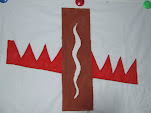The Sun Over Temixtetlan
©
If myth is to be real, it tells the story of a religion, and
not just an ‘ideology’ as some anthropologists, reflecting secular prejudices,
now have come to call it. Myth and religion are synonymous and are to be
respected in the same way as so-called bona fide pseudo ‘religion’ is.
For the Mexican people of the 15th-16th
centuries, their sacred stories were no less interpretable than the Bible or
Koran texts are for Jews, Christians, and Muslims. Reinterpretation can move
forward and backward. Either way, there were many omens that did not bode well
for the capital of the Aztecs, Tenochtitlan Mexico
While the following link tells an interesting story of the
siege of Tenochtitlan
One major factor that contributed to the fall of
I broadly cover the subject of a potential Revolution against
the Aztecs in a blog (Eso sChronicles
178)
outside of this series. I based my argument on the thesis that teomiqui,
self-sacrifice, the way of death by the Gods practiced during the Toltec
civilization, was compromised by the conquering Aztecs, who replaced it with
human sacrifice, to which end they made wars against surrounding nations, took
prisoners its warriors, then sacrificed them on the temple platforms at
Tenochtitlan. This was done because the Aztecs themselves were too cowardly to
rule through the charisma of self-sacrifice.
I
realize that for most anthropologists teomiqui simply means human sacrifice. One may ascertain
this by searching the internet. However, such an interpretation is profoundly
influenced by neo-Christian prejudice against self-sacrifice, which—one may
argue—is the very reason why neo-Christianity was created. Though neo-Christian
Catholicism insists that in the early years neo-Christians did sacrifice their
lives in order to establish Catholicism, the sacrifice was sooner of Christian
‘heretics’ by the Catholic Inquisition financed by secular kings and prices.
Thus, neo-Christianity did all it could to deny the credibility of
self-sacrifice, which it did by proposing resurrection as a solution to a
purported fear of death.
My
early contact with the word teomiqui
came through “City of Sacrifice
In our time other
perspectives have taken hold: “Without resurrection, there can never be any final
reconciliation. But in the absence of reconciliation, or of hope for that,
neither can there be any morality;” so claims Professor John Milbank http://www.firstthings.com/article/2009/02/004-the-ethics-of-self-sacrifice-20
speaking on behalf of neo-Christianity and therewith as if closing the book on
further discussions about the meaning of death and morality. As I understand
it, to the professor a ‘final reconciliation’ means reconciliation with both
death and life.
But what if the
arrival of ‘life’ in a material universe does not ask for such
‘reconciliation’? What if for life its emergence from matter is both natural
and organic? What if for life the achievement of consciousness is implicit in
its being? If so, then surely consciousness and death are preordained, and
resistance to life as organic phenomenon (and an insistence that it be
converted to a supernatural event), means a replacement of organic reality with
a questionable virtualism or para-reality. The ‘reconciled’ neo-Christian
realizes ‘reconciliation’ by agreeing to replace an organic Paradise
with an urban environment.
For the ‘old
world’ of Christianity, however, the reconciliation with reality of death
occurred when its leaders enabled and maintained a community by
self-sacrificing their lives to free the Sun from the arrest of death. The
‘reconciliation’ occurred through self-sacrificial death, which enabled a) the
Sun to rise; b) the community under the Sun to share in a fearlessness of death
like that of its leaders; and c) for the community to reconcile to the idea
that its individuals share in a sufficiently like nature to constitute as a
singularity the community, not the individual.
Before the Aztecs seized power over the territory
formerly governed by the Great Tolan, the Holy of Holies of the Toltec
civilization was located at Teotihuacan
It was at Teotihuacan
Since Mexico
and Central America is a land of many
volcanoes, we may image the pit of fire as having been the caldera of a
volcano. While the Sun gave no light, it was the volcanic fire, reflected
against the thighs of the Sun that gave evidence that there was indeed such a
thing as the Sun.
The Sun was not however impressed with just two
self-sacrifices. She merely acknowledged them. The ‘sign’ of acknowledgement
has been lost by Mexican story tellers, but is still known by the Japanese, who
tell that the Sun, Amaterasu, was coaxed out of the cave in which she had hid
by a mirror, who the Gods claimed embodied the Sun’s replacement. When the Sun
came to look, She indeed thought that her reflection belonged to another sun,
then grew suspicious, and to prove that the reflection was but of herself,
lifted her skirt to prove that the reflection was but of her own thighs and
pubic triangle.
When the Sun was about to reenter the cave, the
Gods realized that all had to take courage similar to that of Nanautzin and
Tecuciztecatl. “Let us all die,” the Gods took courage and agreed. And they all
took their lives by turning into hummingbirds, and then let the Wind Ecatl blow
them into the fire.
Then Ecatl, the only one of the Gods to remain
alive, emptied his lungs completely of breath by blowing on the Sun as hard as
he could. This is how, at last, the Sun was set into motion, daylight came into
being again, and human beings gathered themselves to live in a community.

No comments:
Post a Comment